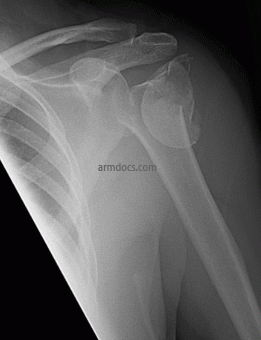How is a proximal humerus fracture diagnosed?
Fractures of the proximal humerus may be suspected from the mechanism of injury resulting in pain and inability to move the shoulder. The arm usually develops swelling and bruising. The diagnosis is confirmed on X-rays of the shoulder. In some instances a CT scan may be arranged to study the fracture in greater detail and allow the surgeon to plan the treatment.
How is a proximal humerus fracture treated?
Non-operative treatment
The initial treatment will consist of supporting the arm in a sling, the use of oral pain medication and advice on protection of the arm. Whilst your arm is in a sling you will be advised to keep the fingers, wrist and elbow moving to prevent stiffness. As the pain in the shoulder settles, you will be encouraged to start gradually moving the shoulder. If the fracture is minimally displaced, then this treatment is continued until the fracture has healed.
Surgical treatment
In some instances, the fracture may be treated surgically. The exact nature of the operation will depend on the type of fracture.
Operative fixation: This method of treatment may be chosen in selected individuals with displaced fractures. It consists of realigning the fragments of bone to restore its shape and then fixing with a plate and screws or a rod (intramedullary nail), which hold the position of the fragments until the fracture has healed. The fracture will usually go on to heal over a period of 3 to 6 months.
Hemiarthroplasty: In individuals who have severe osteoporosis or where the humeral head (ball of the joint) is completely detached from the shaft of the bone, there is a risk that fixation may fail or the head may be deprived of its blood supply resulting in bone death (avascular necrosis). In such instances a partial shoulder replacement (hemiarthroplasty), which replaces the humeral head with a metal implant may be recommended.
Reverse shoulder replacement: In some instances, particularly in older individuals where the bone is severely fragmented or if the function of the shoulder was poor to start with, a Reverse shoulder replacement may be recommended.
How long does it take to recover from a proximal humerus fracture?
Recovery will depend to some extent on the severity of the fracture and the type of treatment. Pain usually starts easing within a couple of weeks. You may start using the hand and elbow as the arm gets comfortable. You will initially be moving the shoulder with assistance and independent use is often allowed after 6-12 weeks. A gradual and progressive functional recovery continues for 12-15 months after the injury.
